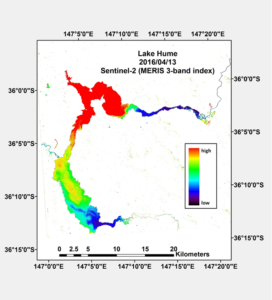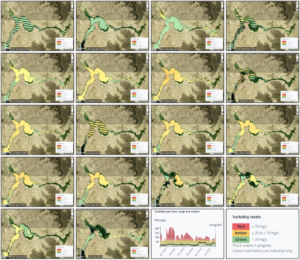Lake Hume – HAB monitoring, forecasting and risk analysis
Project Outline
Numerous species of blue green algae (cyanobacteria) can introduce toxins into water bodies. Predicting and detecting their occurrence and amount in reservoirs and rivers is an important public health issue from the twin perspectives of providing the community with safe drinking water, and aquatic recreation.
Present methods to assess the abundance of blue green algae in water bodies suffer from logistic and technical issues, which can impose delays on reporting results. Moreover, these techniques provide observations only at a particular point in space and time.
The distribution of blue green algae through the water column of many of the toxic species is highly variable due to their varying buoyancy (which can lead to exceptionally high surface concentrations), the local meteorology and the water stratification affected by the short term climate.
Blue-green algal blooms in the Murray River are becoming more frequent in the last few years, with 5 mega-blooms occurring in the last 13 year, compared to, at most, 4 in the proceeding 65 years.
Until the Millennium Drought, blue-green algal blooms in the Murray River were not common (Gutteridge, Hasking & Davey 1974; Croome et al. 1975; Sullivan, Saunders & Welsh 1988; Walker and Hillman 1982; Water ECOscience 2002).
This joint project with colleagues in CSIRO Land and Water seeks to provide water managers with an “early warning system” for timely response to minimize public exposure and risk. We aim to couple remote sensing observations from both satellite and local sensors (HydraSpectra) with modelling of hydrodynamics of the water body, which takes account of the local weather conditions and growth of blue-green algae as shown in the graphs below. The remote sensing technique uses satellite sensors and provides the synoptic scale observations of the algal abundance for whole water body as well as updated boundary conditions for the modelling, while the local in situ sensor provides much higher frequency observations between satellite overpasses.
The height of the algal bloom in Lake Hume 2016
Lake Hume (on the Murray River above Albury) is a test bed for these ideas. It is the major storage for the Murray Basin, and its algal population is thought to influence the algal populations at user sites further downstream. We gather bio-optical data and physical data of the water at sites around the lake for calibration of the satellite of the satellite observations as well as for the calibration /validation of the local bio-optical model.
Remote sensing time Series analysis
A bio-optical model was developed for Lake Hume from the field data collected over several months, to track progression of algal blooms. An algorithm was applied to Landsat data acquired from the Australian Geoscience Datacube (AGDC). Data from 1987 until 2016 was used to characterize the temporal dynamics of Lake Hume’s water quality.
Time series information for Lake Hume
Project Funding
Project regional partners
Water NSW and Goulburn Murray Water
Project Investigator
Project Team

Janet Anstee
- Primary EmailJanet.Anstee@csiro.au

Gemma Kerrisk
- Primary Emailgemma.kerrisk@csiro.au

Dr Paul McInerney
- Primary Emailpaul.mcinerney@csiro.au










